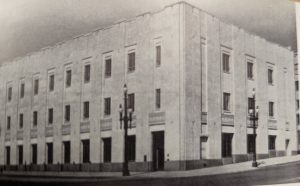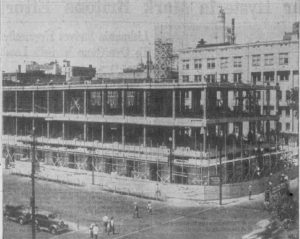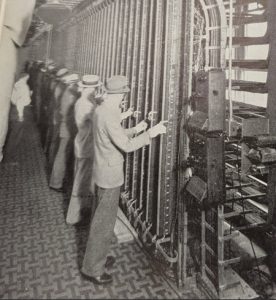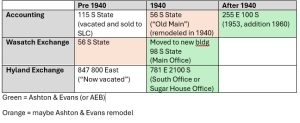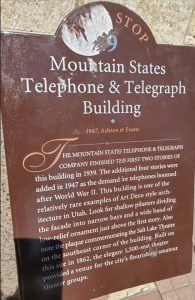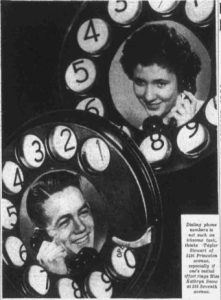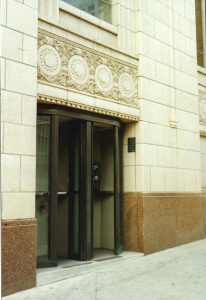Building Also Known As: New Wasatch Exchange
Address: 98 S State
City: Salt Lake City
County: Salt Lake
State: UT
Building Type: Commericial
Style: Art Deco
Work Scope: Original Design
Awards and Nominations: Top number of votes: Outstanding recent architecture in Salt Lake City (Mountain States Telephone).
Client: Mountain States Telephone & Telegraph
Blueprint Available: No.
A&E Related Architect: Robert Bryant (Denver), Ashton & Evans (associates)
A&E Work Approx Date: 1940
Architects Confirmed? Phone company plans.
Original Cost: $485,000 (Dial telephone plans).
Builder: James B. Howell, Denver (Construction of new telephone).
Site Survival? Y (as of 2024)
Site Condition? Excellent
Description
The architectural style of the Salt Lake City 1940 Mountain States Telephone & Telegraph (MST&T) main building is well known as one of the “few Art Deco structures in Utah and … a fine example of this style” (McCormick). But the design is only part of the story. The building construction is least as significant: heavily reinforced to support the expected rapid growth of telephone use after World War II with five addition stories and the new heavy automated switching equipment to replace operator-assisted dialing (National Park).
This property on Main and State streets had been purchased in 1928 with the purpose of erecting a new Mountain States operating and headquarters building. Beginning with the 1929 depression, plans were deferred year-after-year, until construction was finally started in 1939. The original structure included three stories – and a full basement – built of reinforced concrete and steel with a terra cotta exterior and highly polished Platt Canyon (Colorado) granite around the base. The austere form, shallow pilaster motifs creating vertical bays, planar elevation with minimal surface undulation, and restrained low-relief ornament are characteristic of the Art Deco style (McCormick). The structure was designed to accommodate five additional stories if needed in the future (Phone company plans two buildings).
Installation of the actual dial equipment was begun by Western Electric in October 1939 and accepted in May 1940. On August 17, 1940 MST&T accomplished their largest flash cutover from operator-assisted to automated dialing. The common-battery (operator assisted) operations in the Salt Lake Wasatch and Hyland exchanges were changed to automated dial systems at this downtown building, as well as the new Ashton & Evans Sugar House structure. The actual conversion of 44,000 phones in five minutes required a second-by-second project plan which was executed by 260 men. The exciting details are well covered in “Conversation starts at the turn of the dial” (1940).
Number changes were necessary on all lines. The “Wasatch” and Hyland” prefixes were dropped, and all new numbers consisted of five digits, such as 5-4150. Customer education was an essential part of the conversion process (Ford).
Ashton & Evans completed two additions to the building: three additional stories in 1947, and a two-story side addition in 1957. The building remains standing (in 2024), has been used continuously by the telephone company, and retains its historic integrity (National Park).
Research Notes
Research for the Salt Lake City Mountain States building was a different sort of challenge. Rather than having too little information, I had too much. It was difficult to summarize the well-publicized project! Not only was the project covered extensively in the local Salt Lake City press, but I also had access to the eleven relevant years (1939 – 1950) of “The Monitor” - the Denver CO newsletter sent to all MST&T employees in their seven-state area. The Salt Lake City structure and the cutover to automated dialing was covered in detail: everything from the history of the SLC site to the cutover to the several later addition projects. Copies of The Monitor are not easy to come by, but the Telecommunications History Group archives on the 14th floor of the historic Mountain States building in Denver has a complete set. They are only open a few hours a week, and we organized our travel to stop there in Nov 2023. A particular issue with this site was confusion in the locations and names of MST&T sites throughout Salt Lake City (see my attached chart). In addition, while the original 1963 Ashton & Evans inventory includes 28 Ashton & Evans projects, none of these blueprints are available at the Ashton & Evans archive at the University of Utah and I can confirm Ashton & Evans design in only seven of them. Mountain States was very secretive about their projects which makes research difficult!
Sources
- Construction of new telephone exchange buildings progresses. (1939, Aug 13). Salt Lake Tribune. - https://newspapers.lib.utah.edu/ark:/87278/s6sn8pfd/30764213
- Conversation starts at the turn of the dial. (1940, Aug 18). Salt Lake Tribune. - https://newspapers.lib.utah.edu/ark:/87278/s6nyv03z/30777169
- Devine, B. (1940, Sep - Oct). A new telephone system for Salt Lake City. The Monitor: Issued for employees of The Mountain States Telephone and Telegraph Company.
- Dial telephone plans studied. (1939, Feb 16). Salt Lake Tribune. - https://newspapers.lib.utah.edu/ark:/87278/s6yfzwd3/30759149
- Ford, G.W. (1940, Aug 4). Telephone firm places all in readiness for long-awaited switch to dials. Salt Lake Tribune. - https://newspapers.lib.utah.edu/ark:/87278/s6w8ks75/30776726
- McCormick, J.S. (1982). Historic buildings of downtown Salt Lake City. Utah Heritage Foundation.
- Mountain States Telephone and Telegraph building voted outstanding by Salt Lake Citizens. (1940, July). Architectural Record.
- National Park Service (1998, Nov 24). National Register of Historic Places Registration Form: Mtn. States Telephone & Telegraphy Co. Garage. United States Department of the Interior. - https://npgallery.nps.gov/AssetDetail/NRIS/98000827
- Phone company plans two buildings in S.L. (1939, Jan 10). Salt Lake Tribune. - https://newspapers.lib.utah.edu/ark:/87278/s6svq3wj/30757896

